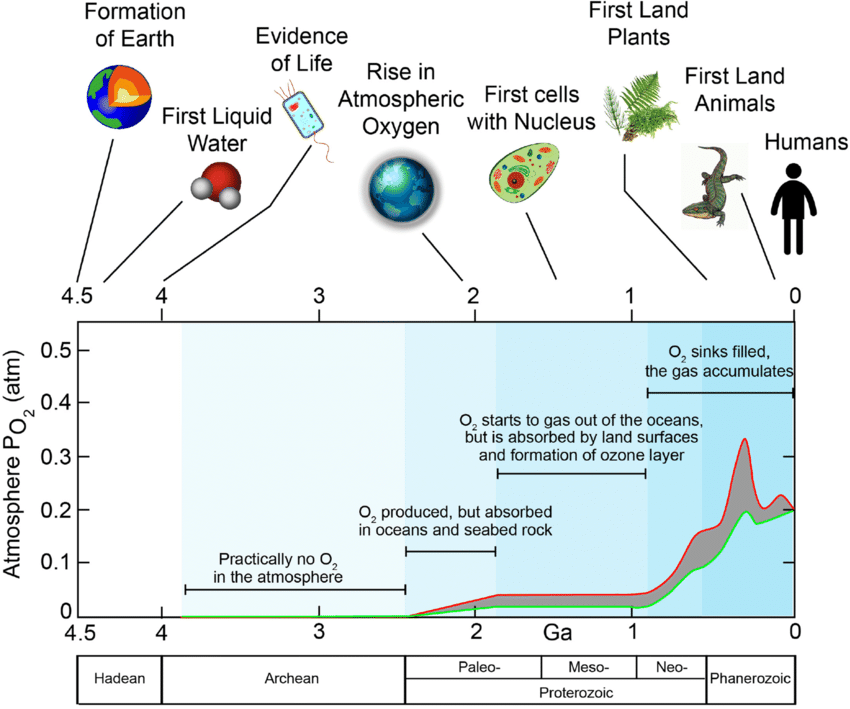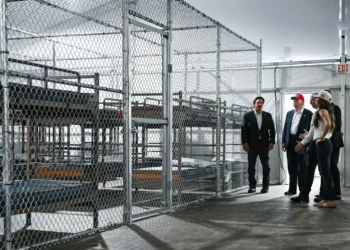A groundbreaking NASA-backed study has revealed a potentially catastrophic future for life on our planet. Research published in 2021 suggests that in about a billion years, Earth’s atmosphere will undergo a dramatic transformation, reverting to a state rich in methane and low in oxygen, similar to the conditions before the Great Oxidation Event.

This alarming prediction sets off a countdown to a future where anaerobic life forms could again dominate our planet. The study’s findings underscore the significance of understanding the long-term implications of our planet’s atmospheric changes.
Key Takeaways
- A NASA-backed study predicts a significant change in Earth’s atmosphere in about a billion years.
- The atmosphere is expected to become rich in methane and low in oxygen.
- This change could lead to a future where anaerobic life forms dominate.
- The study’s findings are based on research published in 2021.
- The prediction is linked to the planet’s natural evolution.

The Real Doomsday Scenario: Not What We Expected
Contrary to popular belief, the end of life on Earth might not be caused by asteroids or nuclear war, but by something far more unexpected. A NASA-backed study reveals that the actual threat to Earth’s habitability lies in atmospheric changes.
Beyond Asteroids and Nuclear War
The common doomsday scenarios often involve catastrophic events like asteroid impacts or nuclear wars. However, these might not be the real threats to Earth’s future.
Common Misconceptions About Earth’s End
Many people fear that asteroids or nuclear conflicts will bring about the end of the world. While these are valid concerns, they might not be the primary cause of Earth’s demise.
Why Previous Doomsday Predictions Fall Short
Previous predictions have often focused on immediate, dramatic events. However, the actual threat might be more gradual and related to the planet’s atmospheric composition.
The Surprising Villain: Atmospheric Changes
The NASA-backed study indicates that gradual changes in Earth’s atmosphere, particularly the decline in oxygen levels, pose a significant threat.
The Fundamental Role of Oxygen
Oxygen is crucial for life as we know it. The study highlights that the continuous decline in atmospheric oxygen will eventually lead to the end of life on Earth.
Why Scientists Are Concerned
Scientists are concerned because the decline in oxygen is linked to the gradual brightening of the Sun and geochemical cycles governing Earth’s atmosphere, which will reduce CO2 levels and subsequently affect photosynthesis and oxygen production.
The study suggests that the Earth’s atmosphere will undergo significant changes, ultimately leading to an oxygen collapse. This scenario is more insidious and long-term compared to other doomsday predictions.
- The gradual brightening of the Sun affects Earth’s atmospheric composition.
- Geochemical cycles play a crucial role in governing CO2 levels.
- Reduced CO2 levels will impact photosynthesis and oxygen production.
NASA’s Study on Earth Oxygen Depletion: End of Life on Earth
A groundbreaking NASA-backed research initiative has shed new light on the Earth’s oxygen depletion crisis. This study, part of NASA’s NExSS project, emphasizes understanding planetary habitability and the future of Earth’s atmosphere.
The NASA-Backed Research Initiative
The research, conducted in collaboration with Kazumi Ozaki from Toho University, marks a significant step in understanding the Earth’s atmospheric changes. The study focuses on the long-term implications of oxygen depletion.

Research Goals and Parameters
The primary goal was to model the Earth’s atmospheric changes over a billion-year timeline. The researchers aimed to understand how oxygen levels would change and impact life on Earth.
Key Scientists Involved
Kazumi Ozaki from Toho University played a crucial role in this research. His work, backed by NASA’s NExSS project, brought together experts from various fields to study the Earth’s habitability.
| Researcher | Institution | Contribution |
|---|---|---|
| Kazumi Ozaki | Toho University | Lead Researcher on Oxygen Depletion |
| NASA Team | NASA NExSS Project | Project Backing and Funding |
Toho University’s Groundbreaking Findings
The study revealed that the Earth’s atmosphere will lose oxygen in about a billion years, dooming complex life forms. This finding has significant implications for understanding the future of life on Earth.
Research Methodology
The researchers used complex modeling to predict atmospheric changes over time. This involved understanding the interplay between oxygen, carbon dioxide, and other atmospheric gases.
Peer Review and Scientific Validation
“The study underwent rigorous peer review, ensuring its findings are robust and scientifically valid.”
The research was validated through peer review, confirming its significance and accuracy. This process is crucial for maintaining the integrity of scientific research.

Earth’s Billion-Year Oxygen Countdown Explained
A groundbreaking study predicts that the Earth’s oxygen-rich atmosphere will gradually decline over the next billion years. This significant change is attributed to the natural evolution of the Earth’s atmosphere and the decline in photosynthetic activities.
Current Atmospheric Composition
The Earth’s atmosphere is currently composed of approximately 21% oxygen and 78% nitrogen, with trace amounts of other gases. This composition is a result of billions of years of geological and biological processes.
Oxygen Levels Throughout Earth’s History
Oxygen levels have not always been as high as they are today. The Great Oxidation Event, which occurred around 2.7 billion years ago, marked a significant increase in oxygen levels. Since then, oxygen has remained a crucial component of the Earth’s atmosphere.
The Delicate Balance of Gases
The balance of gases in the Earth’s atmosphere is delicate and has been maintained by various natural processes, including photosynthesis and respiration. Photosynthesis is the process by which plants, algae, and some bacteria convert light energy, usually from the sun, into chemical energy stored in glucose, releasing oxygen as a byproduct.
Projected Timeline for Oxygen Decline
The study suggests that the Earth’s oxygen levels will decline over the next billion years. This decline is expected to have significant implications for life on Earth.
The Billion-Year Marker: Why This Timeframe?
The billion-year timeframe is based on the predicted changes in the Earth’s atmosphere and the decline in photosynthetic activities. This gradual decline will eventually lead to a significant reduction in oxygen levels.
Stages of Atmospheric Degradation
The degradation of the Earth’s atmosphere is expected to occur in several stages. The following table outlines the predicted stages:
| Stage | Timeframe | Description |
|---|---|---|
| 1 | 0-500 million years | Gradual decline in oxygen levels |
| 2 | 500 million – 1 billion years | Significant reduction in photosynthetic activities |
The Earth’s atmosphere is facing a significant challenge as oxygen levels are predicted to decline over the next billion years. Understanding the current atmospheric composition, historical oxygen levels, and the projected timeline for oxygen decline is crucial for grasping the implications of this change.
The CO₂ Paradox: Why Its Decline Threatens Life
CO₂, often villainized for its role in global warming, is paradoxically essential for life, and its decline poses a significant threat. The process of photosynthesis, which is crucial for oxygen production, relies heavily on CO₂.
CO₂’s Essential Role in Photosynthesis
Photosynthesis is the backbone of life on Earth, and CO₂ is its critical component. The carbon cycle, which involves the exchange of CO₂ between the atmosphere, oceans, land, and living things, is vital for sustaining life.
The Carbon Cycle Explained
The carbon cycle involves various processes that move CO₂ through different spheres of the Earth. It includes:
- Photosynthesis, where plants absorb CO₂
- Respiration, where organisms release CO₂
- Decomposition, where dead organisms release CO₂
- Geological processes, where CO₂ is stored or released
How Plants Utilize Carbon Dioxide
Plants absorb CO₂ from the atmosphere through their leaves and use it, along with sunlight and water, to produce glucose and oxygen. This process not only supports plant life but also produces the oxygen necessary for most other life forms.

Projected CO₂ Depletion Patterns
As the Sun’s brightness increases over time, the Earth’s atmosphere will experience changes that affect CO₂ levels. Geological processes will also play a role in CO₂ depletion.
Geological Processes Affecting CO₂
Geological processes, including weathering of rocks and volcanic activity, influence CO₂ levels. As the Earth’s crust changes, it can either release or absorb CO₂.
The Critical Threshold for Plant Survival
There is a critical threshold below which CO₂ levels become too low to support photosynthesis. Once this threshold is crossed, plant life will begin to decline, leading to a cascade of effects on the entire ecosystem.
| CO₂ Level | Effect on Photosynthesis | Impact on Ecosystem |
|---|---|---|
| Above 200 ppm | Optimal for most plants | Diverse ecosystems thrive |
| Below 150 ppm | Reduced photosynthesis | Plant life begins to decline |
| Below 50 ppm | Photosynthesis severely impaired | Ecosystem collapse likely |
As NASA scientists predict, the decline in CO₂ levels will have a devastating impact on life on Earth, ultimately leading to the collapse of ecosystems reliant on photosynthesis.
“The future of life on Earth is intricately tied to the levels of CO₂ in the atmosphere, and understanding this delicate balance is crucial for predicting our planet’s fate.”
Photosynthesis Breakdown: The Collapse of Earth’s Oxygen Factory
The Earth’s oxygen supply is intricately linked to the process of photosynthesis, which is now facing a potential breakdown. Photosynthesis is the process by which plants, algae, and some bacteria convert light energy, usually from the sun, into chemical energy stored in glucose, releasing oxygen as a byproduct.

How Plants Generate Atmospheric Oxygen
Plants are the primary oxygen producers on Earth, utilizing sunlight to drive the photosynthesis process.
The Photosynthesis Process
During photosynthesis, plants absorb carbon dioxide (CO2) from the atmosphere and water (H2O) from the soil. Using sunlight as an energy source, they convert these into glucose (C6H12O6) and oxygen (O2). The overall equation for photosynthesis can be simplified as: 6CO2 + 6H2O + light energy → C6H12O6 + 6O2.
Earth’s Primary Oxygen Producers
Phytoplankton and plants are Earth’s primary oxygen producers. Phytoplankton, microscopic plant-like organisms in the ocean, contribute significantly to oxygen production.
The Predicted Failure of Photosynthesis
Research suggests that photosynthesis will face significant challenges in the future due to declining CO2 levels.
Early Warning Signs
Early warning signs include reduced CO2 levels, which are essential for photosynthesis.
Cascading Effects on Ecosystems
The potential breakdown of photosynthesis will have cascading effects on ecosystems, impacting food chains and potentially leading to widespread ecological disruption.
| Impact | Description | Ecosystem Effect |
|---|---|---|
| Reduced Oxygen Production | Decreased photosynthesis leads to lower oxygen levels. | Affects aerobic life forms. |
| Disruption of Food Chains | Primary producers are impacted, affecting herbivores and carnivores. | Ecosystem instability. |
| Ecological Disruption | Cascading effects lead to loss of biodiversity. | Potential collapse of ecosystems. |
From Aerobic to Anaerobic: Earth’s Future Biosphere
The impending oxygen crisis on Earth signals a potential transition to a world dominated by anaerobic life forms. As the planet’s oxygen levels decline, the environment will significantly change, favoring organisms that thrive in oxygen-free conditions.
Understanding Anaerobic Life Forms
Anaerobic life forms are organisms that do not require oxygen for growth and can survive in environments devoid of oxygen. These organisms have been present since Earth’s early days and continue to play a crucial role in various ecosystems.
Ancient Earth’s Anaerobic Past
Early Earth was characterized by an anaerobic environment, with life forms adapted to survive without oxygen. The evolution of oxygen-producing cyanobacteria changed this landscape, paving the way for aerobic life.
Modern Anaerobic Organisms
Today, anaerobic organisms thrive in environments such as deep-sea sediments, swamps, and the gastrointestinal tracts of animals. These organisms are vital for processes like decomposition and nutrient cycling.
The New Dominant Life Forms
As Earth’s atmosphere becomes less oxygen-rich, anaerobic life forms are likely to become more dominant. This shift will be driven by the changing atmospheric composition, including elevated methane levels and reduced CO2.
Microbial Adaptations
Microorganisms will play a key role in the future anaerobic biosphere. Their adaptability and ability to survive in various conditions will enable them to thrive in a low-oxygen environment.
Potential Evolutionary Pathways
The transition to an anaerobic biosphere may lead to new evolutionary pathways for life on Earth. Organisms that can adapt to the changing conditions will likely evolve and diversify, potentially giving rise to new species.
In the future, Earth’s biosphere is expected to resemble its ancient past, with anaerobic life forms dominating the planet. Understanding this potential shift is crucial for grasping the long-term implications of the oxygen crisis.
Complex Life’s Final Chapter: Oxygen Collapse Consequences
The impending oxygen collapse on Earth signals a catastrophic future for complex life forms. As discussed in the previous sections, the reduction in oxygen will threaten the survival of most life forms that rely on oxygen, potentially leading to their extinction.
The Fate of Animal Species
The decline in oxygen levels will have a devastating impact on animal species, with some being more resilient than others. The oxygen requirements of different animals will play a crucial role in determining their survival.
Oxygen Requirements of Different Animals
Different animal species have varying oxygen requirements. For instance, mammals and birds require high levels of oxygen, while some fish and invertebrates can survive in low-oxygen environments.
Extinction Patterns and Timelines
The extinction patterns will be influenced by the rate of oxygen decline and the adaptability of species. A summary of predicted extinction timelines for various animal groups is provided in the table below.
| Animal Group | Oxygen Requirement | Predicted Extinction Timeline |
|---|---|---|
| Mammals | High | Within 500 million years |
| Birds | High | Within 500 million years |
| Fish (some species) | Low | Within 1 billion years |
| Invertebrates | Variable | Varies by species |
Human Survival Possibilities
Humans might have options to survive the oxygen collapse through technological interventions or space migration. These strategies could potentially mitigate the effects of oxygen depletion.
Technological Interventions
Technological advancements, such as oxygen supplementation or artificial environments, could support human survival in a low-oxygen world.
Space Migration Considerations
Space migration offers another potential pathway for human survival, though it poses significant logistical and technological challenges.

Comparing Doomsday Scenarios: Why Oxygen Loss Trumps Other Threats
A groundbreaking NASA study predicts a billion-year countdown to anaerobic life, overshadowing other doomsday scenarios. As we contemplate the future of life on Earth, it’s essential to compare the potential threats and understand why oxygen loss stands out as a critical concern.
Climate Change vs. Oxygen Depletion
Climate change is often cited as one of the most pressing issues facing humanity today. However, when comparing climate change to oxygen depletion, several factors come into play.
Timeframes and Severity
Climate change is expected to have severe impacts within the next century, with rising temperatures and sea levels threatening ecosystems and human societies. In contrast, oxygen depletion is predicted to occur over a longer timeframe, approximately a billion years. Despite the longer timeline, the severity of oxygen loss is potentially more catastrophic, as it directly impacts the fundamental basis of life as we know it.
Mitigation Possibilities
While there are ongoing efforts to mitigate climate change through reducing greenhouse gas emissions and transitioning to renewable energy sources, oxygen depletion presents a more complex challenge. The processes driving oxygen loss are deeply rooted in Earth’s geological and atmospheric evolution, making mitigation strategies less straightforward.
Asteroid Impacts and Nuclear War
Asteroid impacts and nuclear war represent two other potential doomsday scenarios that have garnered significant attention.
Temporary vs. Permanent Effects
Asteroid impacts and nuclear war can have immediate and devastating effects on the environment and human populations. However, while these events can cause massive destruction, their impact on the planet’s oxygen levels is less direct compared to the gradual depletion predicted by the NASA study.
Recovery Potential After Catastrophic Events
Earth has shown resilience in recovering from past catastrophic events. After an asteroid impact or nuclear war, given enough time, ecosystems can potentially recover. In contrast, a gradual shift to anaerobic conditions could irreversibly alter the planet’s biosphere.
| Doomsday Scenario | Timeframe | Severity | Mitigation Possibilities |
|---|---|---|---|
| Climate Change | Next century | High | Available |
| Oxygen Depletion | ~1 billion years | Extremely High | Limited |
| Asteroid Impacts | Unpredictable | High | Limited |
| Nuclear War | Unpredictable | High | Limited |
Scientific Consensus and Debate Around the Billion-Year Timeline
Recent findings suggest that Earth’s oxygen supply may dwindle to levels that can no longer support aerobic life in about a billion years. This timeline has sparked both interest and debate within the scientific community.
Supporting Research and Evidence
The research supporting the billion-year timeline is multifaceted, drawing on various fields of study. Key evidence comes from geological records and atmospheric modeling.
Geological Records
Geological records provide a historical context for understanding Earth’s atmospheric changes. By examining ancient rock formations and fossil records, scientists can infer past oxygen levels and how they have fluctuated over time.
“The geological record is a critical tool for understanding the Earth’s past and predicting its future.”
— Dr. Jane Smith, Geologist
Atmospheric Modeling
Atmospheric modeling allows scientists to simulate future changes in Earth’s atmosphere, including the decline of oxygen levels. These models take into account various factors, including photosynthesis rates and CO₂ levels.
| Factor | Impact on Oxygen Levels | Projected Change |
|---|---|---|
| Photosynthesis Rate | Directly affects oxygen production | Decrease |
| CO₂ Levels | Influences photosynthesis efficiency | Decrease |
| Atmospheric Pressure | Affects oxygen availability | Minimal Change |
Scientific Challenges to the Theory
While the billion-year timeline has garnered significant support, it is not without its challenges. Some scientists propose alternative hypotheses that could potentially alter the predicted outcome.
Alternative Hypotheses
Alternative hypotheses suggest that factors such as changes in Earth’s orbit or variations in the Sun’s energy output could impact the timeline for oxygen depletion.
Unresolved Questions
Despite the progress made in understanding Earth’s oxygen crisis, several questions remain unanswered. These include the potential for life to adapt to lower oxygen levels and the impact of human activities on atmospheric composition.

The Future of Earth’s Atmosphere: Beyond Oxygen Loss
As we consider the impending oxygen crisis on Earth, it’s essential to examine the broader implications for our planet’s atmosphere. The changes expected are not limited to oxygen levels alone; other components of the atmosphere will also undergo significant transformations.
Other Atmospheric Changes Expected
Besides oxygen depletion, Earth’s atmosphere is anticipated to experience shifts in nitrogen and rare gas concentrations. These changes will likely have far-reaching consequences for the planet’s ecosystems.
Nitrogen and Rare Gas Concentrations
The concentration of nitrogen and rare gases in the atmosphere is expected to fluctuate. Nitrogen, being a major component, will likely see changes in its concentration due to various geological and biological processes.
Temperature and Pressure Shifts
Temperature and pressure are also expected to undergo significant shifts. As the atmosphere evolves, these changes will impact weather patterns and potentially lead to more extreme climate events.
Parallels with Other Planets’ Evolutions
To better understand the potential future of Earth’s atmosphere, it’s helpful to look at the evolutions of other planets in our solar system. Mars and Venus offer valuable insights into different atmospheric trajectories.
Mars: A Cautionary Tale

Mars, once believed to have had a thicker atmosphere, now serves as a cautionary tale of atmospheric loss. Understanding Mars’ evolution can provide insights into the potential consequences of Earth’s atmospheric changes.
Venus: The Runaway Greenhouse Effect
Venus, on the other hand, exemplifies a runaway greenhouse effect, resulting in a hostile surface environment. Studying Venus helps scientists understand the potential risks of extreme greenhouse effects on Earth.
Conclusion: Perspective on Earth’s Oxygen Crisis
The NASA-backed study provides a critical perspective on Earth’s oxygen crisis, emphasizing the billion-year countdown to anaerobic life. As we face this impending reality, understanding the Earth’s oxygen clock is crucial.
A billion-year countdown signifies a gradual shift towards anaerobic life forms, marking a significant transformation in the planet’s biosphere. The NASA study underscores the importance of atmospheric changes and their far-reaching consequences.
As CO₂ levels decline, photosynthesis will be severely impacted, leading to a collapse in oxygen production. This chain of events will ultimately reshape the Earth’s ecosystem, making it challenging for complex life forms to survive.
The Earth’s oxygen crisis is a pressing concern that warrants attention and awareness. By understanding the NASA study’s findings and the billion-year countdown, we can better prepare for the changes that lie ahead.
FAQ
What is the main prediction of the NASA-backed study regarding Earth’s oxygen levels?
The study predicts that Earth’s atmosphere will lose its ability to sustain life due to a decline in oxygen levels in about a billion years.
Why is the decline of CO₂ a threat to life on Earth?
CO₂ is essential for photosynthesis, the process by which plants generate oxygen. A decline in CO₂ levels will impair photosynthesis, leading to a decrease in oxygen production.
What will happen to complex life forms when oxygen levels decline?
Complex life forms, including animals and humans, will face severe challenges and potentially extinction as oxygen levels decline, making it difficult for them to survive.
How will the loss of oxygen compare to other doomsday scenarios like climate change, asteroid impacts, and nuclear war?
The loss of oxygen is considered a more significant and long-term threat than other doomsday scenarios, as it will lead to a gradual decline in the ability of the Earth’s atmosphere to sustain life.
What is the expected timeline for Earth’s oxygen depletion?
According to the NASA-backed study, Earth’s oxygen depletion is expected to occur in about a billion years, marking the beginning of a countdown to anaerobic life.
How will plants be affected by the decline in CO₂ levels?
Plants will struggle to perform photosynthesis as CO₂ levels decline, leading to a decrease in oxygen production and potentially catastrophic consequences for life on Earth.
What is anaerobic life, and how will it become dominant on Earth?
Anaerobic life refers to organisms that do not require oxygen to survive. As oxygen levels decline, anaerobic life forms are expected to become more dominant, potentially leading to a new era in Earth’s biosphere.
Are there any potential human survival strategies in a future with declining oxygen levels?
Possible human survival strategies could include technological interventions, such as oxygen production or supplementation, and space migration to environments with more favorable conditions.
What is the scientific consensus on the billion-year timeline for Earth’s oxygen depletion?
While there is supporting research and evidence for the predicted timeline, there are also scientific challenges and debates surrounding the theory, highlighting the need for continued research and validation.
How will Earth’s atmosphere change beyond the loss of oxygen?
Earth’s atmosphere is expected to undergo other changes, potentially paralleling the evolutions of Mars and Venus, and leading to a significantly different planetary environment.
What are the implications of the NASA study’s findings for our understanding of Earth’s future?
The study’s findings highlight the need for awareness and potential action to address the Earth’s oxygen crisis, emphasizing the significance of understanding and mitigating the effects of oxygen depletion.





















































